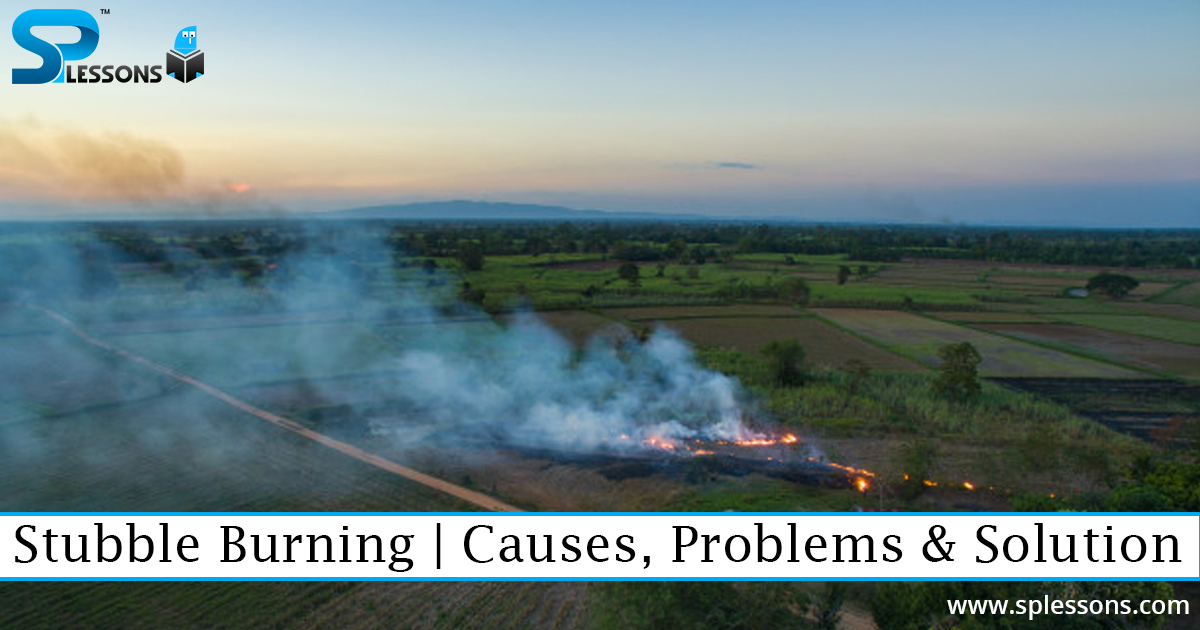 Topic
Topic
Stubble Burning
 Essay
Essay
The burning of crop effluents throughout the agricultural belt accounts for a large share of air pollutants in Delhi.
Stubble Burning - What are the major issues of stubble burning?
The current rise in air pollution standards in Northern India has generated alarm about people's health there.
-
1. In the region of the National Capital Region (NCR), respiratory diseases like COPD and asthma are up by 50%.
2. It also leads to soil fertility loss and cancer cases in Punjab and Haryana are growing.
3. Burning of crop waste discharges tons of carbon dioxide, carbon monoxide, and other pollutants material.
-
1. Haryana and Punjab farmers have to switch very soon to the next winter crop, after the Rabi plantation.
2. Pests such as termites can destroy future crops if parali is abandoned on the field.
3. Burning is, therefore, the least expensive way to extract stubble.
STUBBLE BURNING:
It means willfully lays fire into the straw left after the grains have been harvested, such as paddy, wheat, and so on.
Leading organic fertilizer can be extracted from the crop leftover.
-
I. The crop leftover includes large quantities of nitrogen, phosphorus, potassium, and sulphur.
II. During stubble burning, organic carbon is also burned.
III. Parali provides a good source to fulfill crop nutrient demands and maintain soil fertility.
IV. Such nutrients also minimize the danger of cancer in Punjab by lowering the rates of carcinogens in soil.
-
a) Sparing planning and sowing time in the field for 7 to 10 days.
b) The decrease in the use of weedicides by 50-70% and
c) Limit the need for irrigation by 40%.
-
a) This enables to prevent the emission of fine particles into the air.
b) It provides the soil with nutrients.
WHAT IS COPD?
Chronic Obstructive Pulmonary Disease (COPD) is a common lung disease, which makes it difficult for a person to breathe.
Farmer’s lack of awareness is the main obstacle.
-
A. Cost vs. possible advantages of various methods remains unclear among farmers.
B. Absence of managing and significant-time assistance for acts relevant to their field, soil type, etc.
C. Absence of farmer consultation facilities at the right time to give the correct knowledge input.
D. Also, a key obstacle is the absence of accessibility to agricultural equipment for in-situ straw handling.
It is vital to communicate effectively and to reach the farmers.
- For this purpose, farmers’ cooperatives, farmers’ associations and local structures such as panchayats can be developed.
- Skilled government officials and volunteers could participate in mass awareness campaigns in target districts.
- Vocational training will also significantly favor farmers.
- Towards this goal, the state must interfere and involve established processes such as MNREGA.
- The Centre should permit states to provide in MNREGA activities such as harvesting and composting. It’s been a request of many states for many years.
- To produce high-grade compost, Parali can be combined with cow dung and decrease air pollution in North India.
- Gauthans are established in Chhattisgarh to fix this problem.
- A gauthan is a five-acre assigned plot shared by each village.
- All leftover parali is obtained by contributions from people and transformed by rural youth into organic fertilizer. It grants them a living.
- The government mainly encourages the transport of parali to the nearby gauthan from the farm.
Did You Know?
In-situ is a Latin phrase that means "on-site" or "in position".
Integrated regenerative rural development model
It includes the restoration of rivers, preservation of animals, composting, and kitchen garden which use MNREGA via a representational system.
Agriculture mechanization
- In 2018, the government introduced a mechanization program for agriculture.
- This program offered a subsidy to buy the necessary equipment like Happy Seeders, zero till, mulcher, etc.
- The subsidy policy should be expanded to create widespread utilization of mechanization beyond 2020.
- The policy can be merged with banking and NABARD schemes to enable credit connections and decrease the burden of machine advance payment by farmers.
- Furthermore, all suggested machines must be incorporated in the subsidy program, providing farmers different choices based on the activity they choose.
Did You Know?
Ex-situ management
- NABARD was founded on 12 July 1982.
- Headquarters – in Mumbai
- Once paddy is substituted with potato or vegetable crops, farmers choose to take the straw out of the fields rather than composting or combining them.
- Ex-situ straw management provides choices for small scale or large scale commercial use of crop leftovers.
- Compost, biogas, fodder, fertilizers, fuel, fiberboards are the main components.
- R&D is needed for the whole straw market and could establish rural startups’ business designs.
- Corporations, government departments, state universities, farmers’ groups, and volunteers should properly promote this.
- The government should support the application of ex-situ straw machines.
- A committee of economists, agricultural experts, farmer delegates, and bureaucrats should be established by the Supreme Court.
- This committee has to analyze the parali burning problem and discuss opportunities for the development of schemes such as MNREGA for harvesting and composting.
- A societal involvement that utilizes traditional knowledge and available resources and helped by governmental backing can improve this national issue.
Did You Know?
- MNREGA means Mahatma Gandhi National Rural Employment Guarantee Act, 2005.
- First proposed – in 1991 - by PV Narasimha Rao






